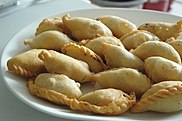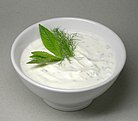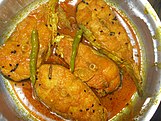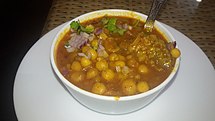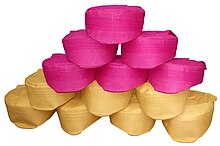The native language in Mithila is Maithili, and its speakers are referred to as Maithils.
The name Mithila is commonly used to refer to the Videha Kingdom, as well as to the modern-day territories that fall within the ancient boundaries of Videha. In the 18th century, when Mithila was still ruled in part by the Raj Darbhanga, the British Raj annexed the region without recognizing it as a princely state. Mithila comprises Tirhut, Darbhanga, Kosi, Purnia, Munger, Bhagalpur and Santhal Pargana divisions of India and some adjoining districts of Nepal.
History:
Mithila first gained prominence after being settled by Indo-Aryan peoples who established the Videha kingdom. During the late Vedic period (c. 1100–500 BCE), Videha became one of the major political and cultural centers of South Asia, along with Kuru and Pañcāla. The kings of the Videha Kingdom were called Janakas. The Videha Kingdom was later incorporated into the Vajji Confederacy, which had its capital in the city of Vaishali, which is also in Mithila.
Medieval period
From the 11th century to the 20th century, Mithila was ruled by various indigenous dynasties. The first of these were the Karnatas, the Oiniwar Dynasty who were Maithil Brahmins and the Khandavalas of Raj Darbhanga who were also Maithil Brahmins. King Rameshwar Singh Bahadur(1860-1929) It was during this period that the capital of Mithila was shifted to Darbhanga.
Tughlaq had attacked and taken control of Bihar, and from the end of the Tughlaq Empire until the establishment of the Mughal Empire in 1526 there was anarchy and chaos in the region. Akbar (ruled 1556–1605) realised that taxes from Mithila could only be collected if there was a king who could ensure peace there. The Brahmins were dominant in the Mithila region and Mithila had Brahmin kings in the past.
Akbar summoned Rajpandit Chandrapati Thakur to Delhi and asked him to name one of his sons who could be made caretaker and tax collector for his lands in Mithila. Chandrapati Thakur named his middle son, Mahesh Thakur, and Akbar declared Mahesh Thakur as the caretaker of Mithila on the day of Ram Navami in 1557 AD.
Lakshmeshwar Singh (Reign 1860-1898) was the eldest son of Maharaja Maheshwar Singh of Darbhanga. He along with his younger brother Rameshwar Singh received a western education from Government appointed tutors as well as a traditional Indian education from a Sanskrit Pandit. spent approximately £300,000 on relief work during the Bihar famine of 1873–74. He constructed hundreds of miles of roads in various parts of the Raj, planting them with tens of thousands of trees for the comfort of travellers, as part of generating employment for people effected by famine. He constructed iron bridges over all the navigable rivers
He built, and entirely supported, a first-class Dispensary at Darbhanga, which cost £3400; a similar one at Kharakpur, which cost £3500 ; and largely contributed to many others.
He built an Anglo-vernacular school at a cost of £1490, which he maintained, as well as nearly thirty vernacular schools of different grades; and subsidised a much larger number of educational institutions. He was also one of the founders of Indian National Congress as well as one of the main financial contributor thereto Maharaja Lakshmeshwar Singh is known for purchasing Lowhter Castle for the venue of the 1888 Allahabad Congress session when the british denied permission to use any public place. The British Governor commissioned Edward Onslow Ford to make a statue of Lakshmeshwar Singh. This is installed at Dalhousie Square in Kolkata.
On the occasion of the Jubilee of the reign of Queen Victoria, Lakshmeshwar Singh was created a Knight Commander of the Most Eminent Order of the Indian Empire, being promoted to Knight Grand Commander in 1897. He was also a member of the Royal Commission on Opium of 1895, formed by British Government along with Haridas Viharidas Desai who was the Diwan of Junagadh. The Royal Opium Commission consisted of a 9-member team of which 7 were British and 2 were Indians and its chairman was Earl Brassey.
Culture:
Madhubani Painting-
Madhubani art (Mithila painting) is practiced in the Mithila region of India and Nepal. Mithila Painting traditionally created by the women of different communities of the Mithila region. It is named after Madhubani district of Bihar, India which is where it originated.
This painting as a form of wall art was practiced widely throughout the region; the more recent development of painting on paper and canvas originated among the villages around Madhubani, and it is these latter developments that may correctly be referred to as Madhubani art.
Maithil Cuisine:
Maithil cuisine is a part of Indian cuisine and Nepalese cuisine. It is a culinary style which originated in Mithila. Some traditional Maithil dishes are:
- Dahi-Chura
- Vegetable of Arikanchan
- Ghooghni
- Traditional Pickles, made of fruits and vegetables which are generally mixed with ingredients like salt, spices, and vegetable oils and are set to mature in a moistureless medium.
- Tarua of Tilkor
- Bada
- Badee
- Yogurt
- Maachh
- Mutton
- Irhar
- Pidakia ( also known as Gujia) which is basically dumplings.
- Makhan Payas
- Anarasa
- Bagiya
The Paag is a headdress in the Mithila region of India and Nepal worn by Maithil people. It is a symbol of honour and respect and a significant part of Maithil culture.
The Paag dates back to pre-historic times when it was made of plant leaves. It exists today in a modified form. The Paag is wore by the whole Maithil community .The colour of the Paag also carries a lot of significance. The red Paag is worn by the bridegroom and by those who are undergoing the sacred thread rituals. Paag of mustard colour is donned by those attending wedding ceremonies and the elders wear a white Paag.
This Paag now features place in the popular Macmillan Dictionary. For now, Macmillan Dictionary explains Paag as “a kind of headgear worn by people in the Mithila belt of India.”
On 10 February 2017, India Posts released a set of sixteen commemorative postage stamps on "Headgears of India". The Mithila Paag was featured on one of those postage stamps.
Language:
People of Mithila region speaks Maithili for the most of time whereas they used to speak other languages like Hindi, Nepali, English, Bhojpuri for other different purposes.
While Maithilis living in Nepal also use Nepali language. And some also use Bengali language in significant part of Bihar-Bengal region.
This language is an Indo-Aryan language native to the Indian subcontinent, mainly spoken in India and Nepal and is one of the 22 recognised Indian languages. In Nepal, it is spoken in the eastern Terai and is the second most prevalent language of Nepal. Tirhuta was formerly the primary script for written Maithili. Less commonly, it was also written in the local variant of Kaithi. Today it is written in the Devanagari script.
Thank's,
Priti Jha






